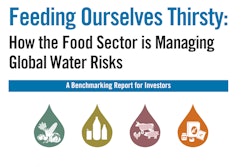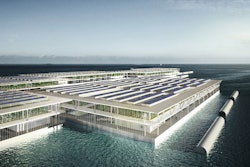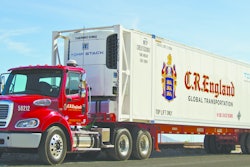
Water is essential to life. Humans, animals and most plant foods comprise 50 to 90 percent moisture, which makes water an important component of agriculture and food production. Water in food comes from rain, water in soil (ground water) and/or irrigation water. Activities that affect water availability and quality can thus directly influence food availability and security. The global food crisis in 2008 was partly due to drought in major grain-producing regions. In 2012, extensive drought in the United States and Canada affected many major field crops with consequent impacts on commodity, feed and food prices.
Whereas the total amount of water on the planet remains constant, its distribution and quality do not. The water cycle is a process where water from oceans and other sources on land evaporate and condense as cloud and through wind movement are transported from one region to another. Through precipitation, this moisture ultimately falls back down on earth as rain, hail or snow. The process ensures that water remains in constant motion around the globe. Regions that get precipitation receive water that supports agricultural production, in addition to other available water sources when present. Regions that do not get enough precipitation may experience drought which, when coupled with inadequate supplies of alternative water sources, could negatively affect agriculture and food production.
The population of the world, now over 7 billion, is expected to rise to 9 billion by 2050. Globally, it is estimated that over 860 million people are malnourished and this number will likely increase if appropriate steps are not taken (www.fao.org). Assuring adequate food supplies requires a focus on food security as well as water security. Agriculture and the food production sectors remain the greatest users of fresh water, accounting for over 70 percent of fresh water withdrawal (www.unwater.org). Despite the large amounts of water present on earth only a small fraction (~3 percent) is available as fresh water that can be used in food production and consumption. Judicious use of water at each stage of food production and processing is, therefore, imperative.
The major elements of water security in regards to food production include availability and accessibility, utilization, quality and safety. Water management in agricultural production and food processing requires good knowledge of available sources of water, their quantity, accessibility, use and fitness-for-use. In many instances, water use can be optimized by reducing, reusing, and recycling. In agriculture, careful attention must be paid to water quality such as salinity, acidity and alkalinity as this can affect soil quality and crop yields.
Additionally, water can contain microbiological, biochemical and chemical hazards, which must be removed prior to or during processing to safeguard the food supply. In many regions, water standards are set for food use to protect the safety of food and these standards should be adhered to as part of a water management program. Furthermore, high moisture foods may be more susceptible to spoilage and could be costly to transport. Thus, methods that decrease food moisture content in an environmentally friendly, cost effective manner will ensure a safer food supply while decreasing cost.
In summary, effective water management practices are key components of sustainable agricultural practices. To address water security, good water management must be practiced along the entire food supply chain from production, processing, storage and distribution through consumption.















